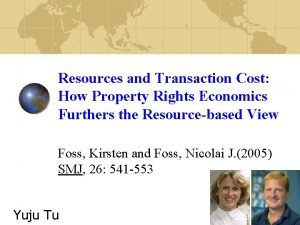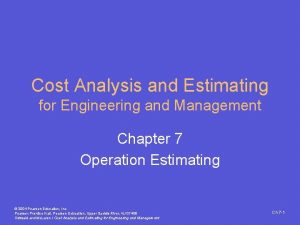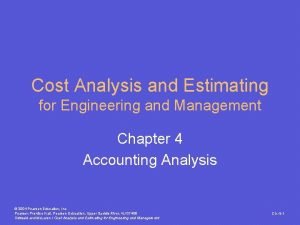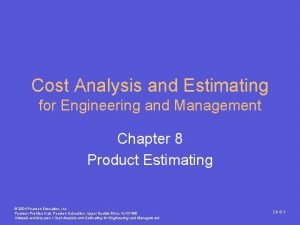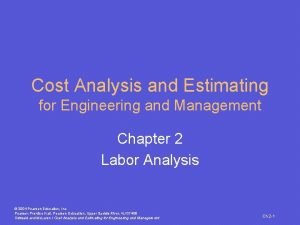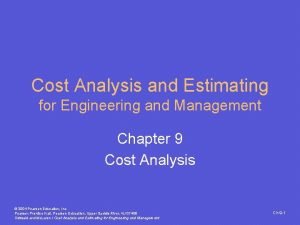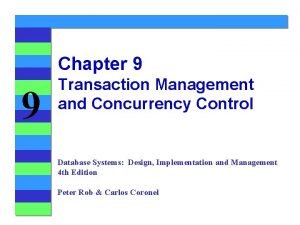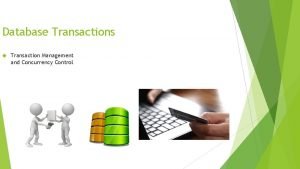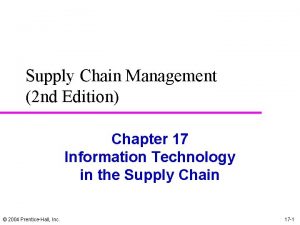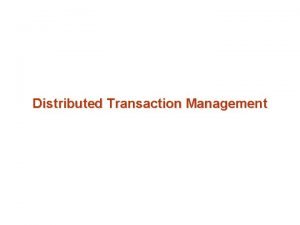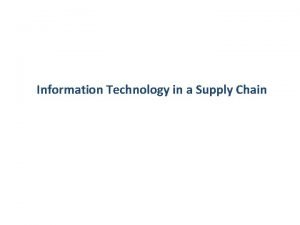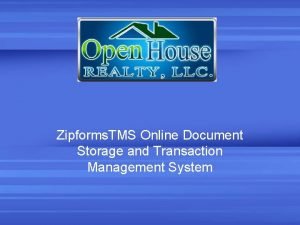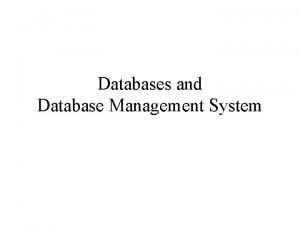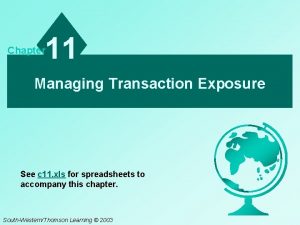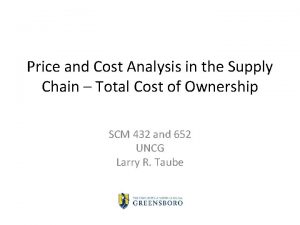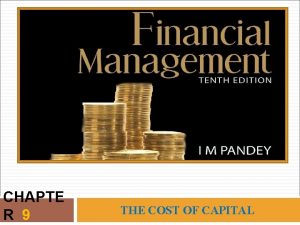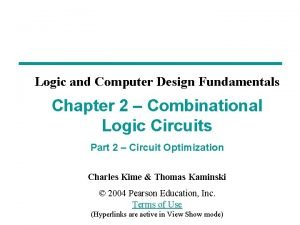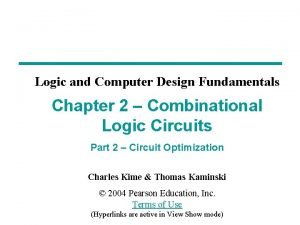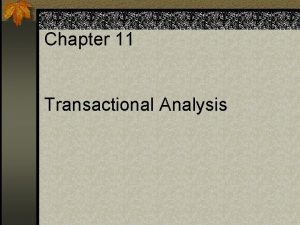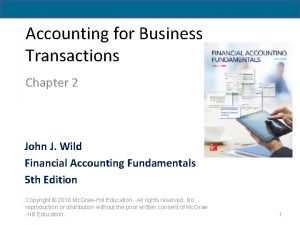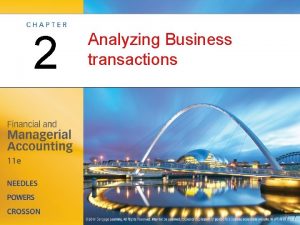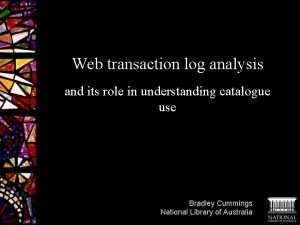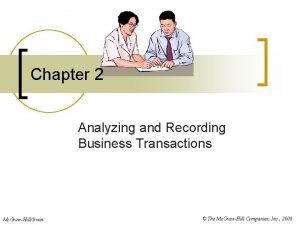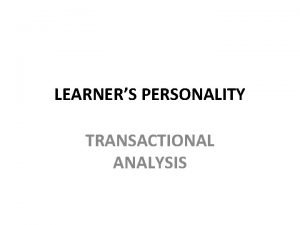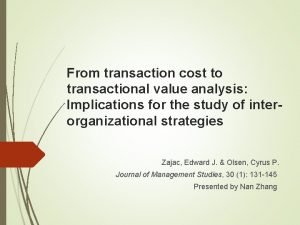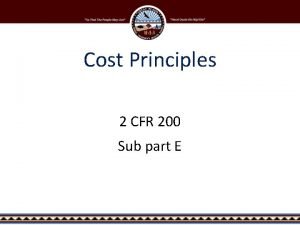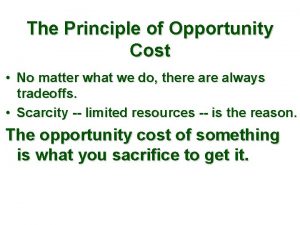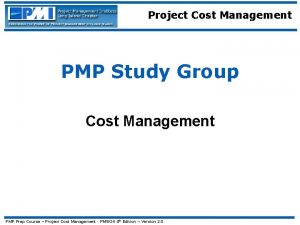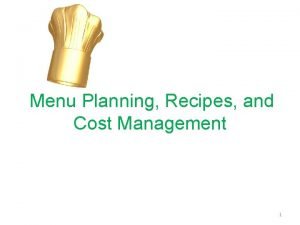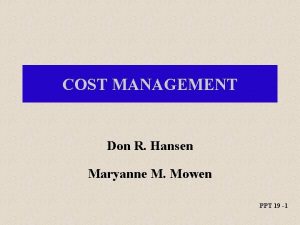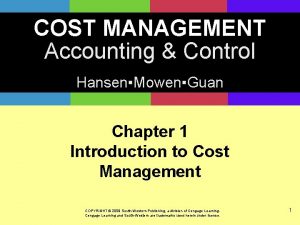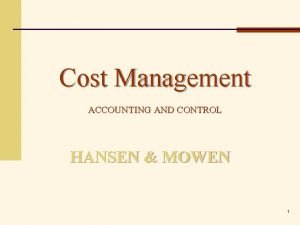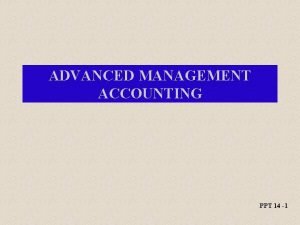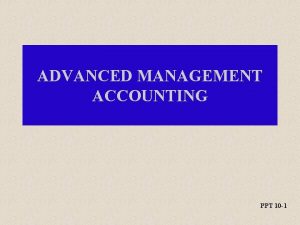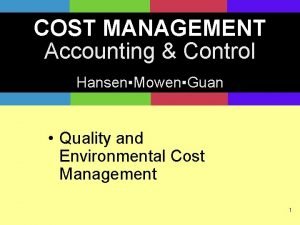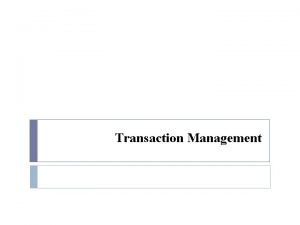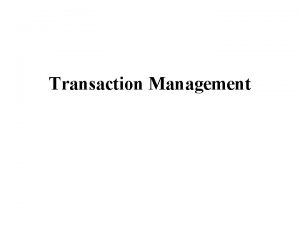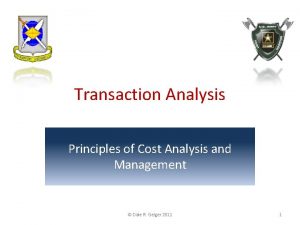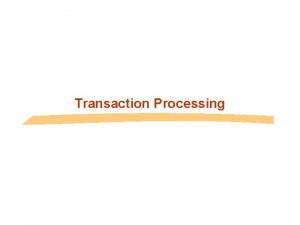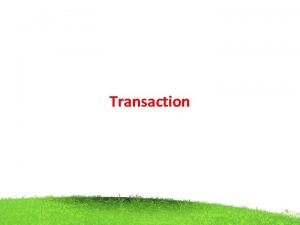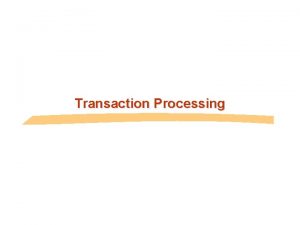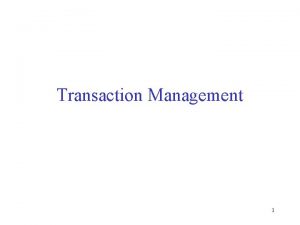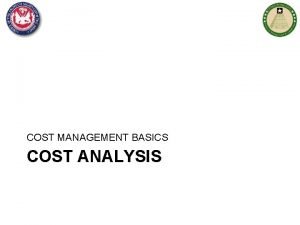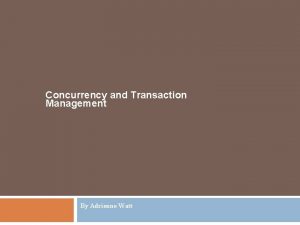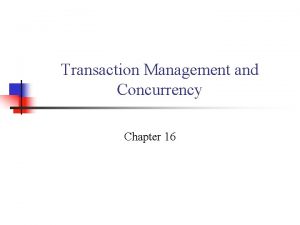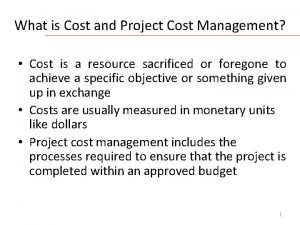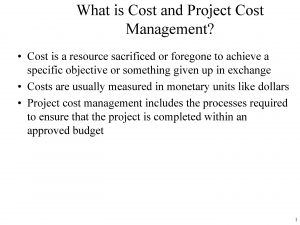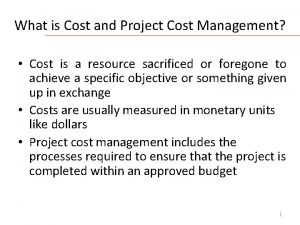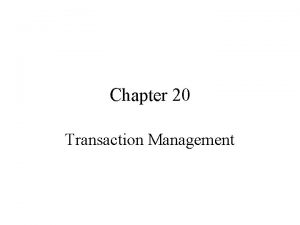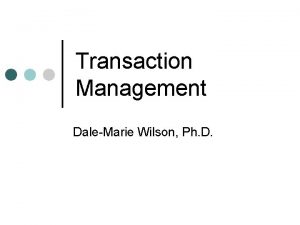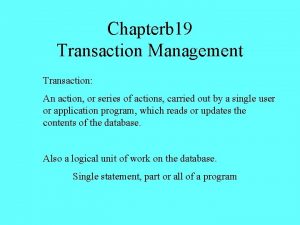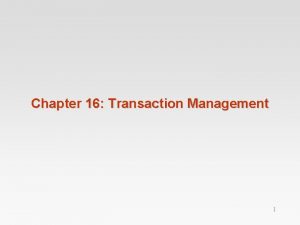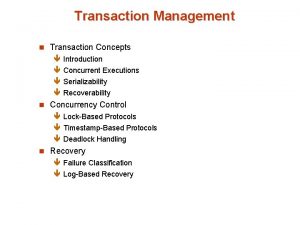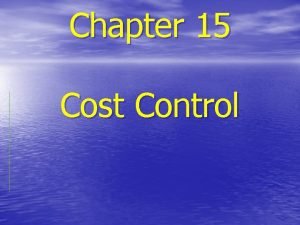Transaction Analysis Principles of Cost Analysis and Management





























































- Slides: 61

Transaction Analysis Principles of Cost Analysis and Management © Dale R. Geiger 2011 1

Terminal Learning Objective • Action: Demonstrate How Transactions Affect the Accounting Equation • Condition: You are a cost advisor technician with access to all regulations/course handouts, and awareness of Operational Environment (OE)/Contemporary Operational Environment (COE) variables and actors. • Standard: With at least 80% accuracy: • Explain accounting terminology • Analyze transactions for effects on the accounting equation • Enter transactions into the accounting equation © Dale R. Geiger 2011 2

Lacy’s Lemonade Stand • Lacy Simmons receives a $200 transfer from the family to start a lemonade stand. • The lemonade stand will run as a revolving fund • User fees must cover costs • Uses Accrual Basis of Accounting • How will this be recorded in the Family’s financial equation? © Dale R. Geiger 2011 3

What’s the Difference? • Consider the purchasing sequence: Plan Order Receive Pay Asset & Liability Remove Liability Consume Expense Accrual accounting records an asset and a liability when the goods are received …and an expense when goods are consumed © Dale R. Geiger 2011 4

Review: Financial Position • The following equation represents financial position: • Assets = Liabilities + Financial Position • What is an asset? • Something owned that represents future benefit • What is a liability? • Something owed or a creditor’s claim against assets • Financial position can also be called equity, net assets, or fund balance © Dale R. Geiger 2011 5

Review: Financial Position • The following equation represents financial position: • Assets = Liabilities + Financial Position • What is an asset? • Something owned that represents future benefit • What is a liability? • Something owed or a creditor’s claim against assets • Financial position can also be called equity, net assets, or fund balance © Dale R. Geiger 2011 6

Review: Financial Position • The following equation represents financial position: • Assets = Liabilities + Financial Position • What is an asset? • Something owned that represents future benefit • What is a liability? • Something owed or a creditor’s claim against assets • Financial position can also be called equity, net assets, or fund balance © Dale R. Geiger 2011 7

Review: Financial Position • The following equation represents financial position: • Assets = Liabilities + Financial Position • What is an asset? • Something owned that represents future benefit • What is a liability? • Something owed or a creditor’s claim against assets • Financial position can also be called equity, net assets, or fund balance © Dale R. Geiger 2011 8

Review: Financial Activity • The following equation represents financial activity: Revenue – Cost = Change in Financial Position • What is a revenue? • Represent earnings received in cash • Increase Assets and Increase Financial Position • What is a cost? • Represent cash payments for goods and services received • Decrease Assets and Decrease Financial Position © Dale R. Geiger 2011 9

Review: Financial Activity • The following equation represents financial activity: Revenue – Cost = Change in Financial Position • What is a revenue? • Represent earnings received in cash • Increase Assets and Increase Financial Position • What is a cost? • Represent cash payments for goods and services received • Decrease Assets and Decrease Financial Position © Dale R. Geiger 2011 10

Review: Financial Activity • The following equation represents financial activity: Revenue – Cost = Change in Financial Position • What is a revenue? • Represent earnings received in cash • Increase assets and increase financial position • What is a cost? • Represent cash payments for goods and services received • Decrease Assets and Decrease Financial Position © Dale R. Geiger 2011 11

Review: Financial Activity • The following equation represents financial activity: Revenue – Cost = Change in Financial Position • What is a revenue? • Represent earnings received in cash • Increase assets and increase financial position • What is a cost? • Represent cash payments for goods and services received • Decrease assets and decrease financial position © Dale R. Geiger 2011 12

Review: Three Ways to Measure • Cash Basis: Plan Order Receive Pay Consume • Budgetary Basis: • Accrual Basis: © Dale R. Geiger 2011 13

Review: Three Ways to Measure • Cash Basis: Plan Order Receive Pay Consume • Budgetary Basis: Plan Commitment Order Obligation Expenditure • Accrual Basis: © Dale R. Geiger 2011 14

Review: Three Ways to Measure • Cash Basis: Plan Order Receive Pay Consume • Budgetary Basis: Plan Commitment Order Obligation Expenditure • Accrual Basis: Plan Order Receive Asset & Liability Remove Liability © Dale R. Geiger 2011 Expense 15

The Accrual Basis of Accounting • Focuses on exchange of Economic Resources • Records Revenues in the period in which they are EARNED • Providing a service • Selling a product Plan Take Orders Complete Service or Ship Product Collect Cash Revenue & Non-Cash Asset © Dale R. Geiger 2011 16

Revenue Comparison • Cash Basis: Plan Take Orders Complete Service or Ship Product Collect Cash • Accrual Basis: Plan Take Orders Revenue & Non-Cash Asset © Dale R. Geiger 2011 17

The Accrual Basis of Accounting • “Matches” Revenues with Expenses • It take money to make money • Records Expenses in period INCURRED • Resources Consumed Plan Order Receive Pay Asset & Liability Remove Liability © Dale R. Geiger 2011 Consume Expense 18

Terminology • How do expenses differ from costs? costs • Costs can be measured in various ways, according to management’s use of the information • Expenses are measured according to generally accepted accounting principles © Dale R. Geiger 2011 19

Terminology • Expenses may be recorded before cash is paid, when cash is paid, or after cash is paid • Expense before cash: • Employees work two weeks at the end of September but will be paid in October • Expense after cash: • Insurance premium for one year is paid 30 -Sept and benefits the next fiscal year © Dale R. Geiger 2011 20

Terminology • How do expenses differ from expenditures? expenditures • Expenditures represent the using up of an appropriation, and are recorded in the period goods or services are received • Expenses are recorded in the period resources are consumed © Dale R. Geiger 2011 21

Consider Office Supplies • Under Budgetary Accounting: Plan Commitment Order Obligation Receive Pay Consume Expenditure • Under Accrual Accounting: Plan Order Receive Asset & Liability Remove Liability © Dale R. Geiger 2011 Expense 22

It’s ok, we bought this paper last year! © Dale R. Geiger 2011 23

Terminology • An account is a RECORD of the CHANGES in a particular asset, liability, revenue, expense or element of financial position • A transaction represents an EXCHANGE of RESOURCES that affects two or more accounts • External transactions involve exchanging resources with parties outside the organization • Internal transactions involve exchanges within the organization © Dale R. Geiger 2011 24

Terminology • An account is a RECORD of the CHANGES in a particular asset, liability, revenue, expense or element of financial position • A transaction represents an EXCHANGE of RESOURCES that affects two or more accounts • External transactions involve exchanging resources with parties outside the organization • Internal transactions involve exchanges within the organization © Dale R. Geiger 2011 25

Terminology • An account is a RECORD of the CHANGES in a particular asset, liability, revenue, expense or element of financial position • A transaction represents an EXCHANGE of RESOURCES that affects two or more accounts • External transactions involve exchanging resources with parties outside the organization • Internal transactions involve exchanges within the organization © Dale R. Geiger 2011 26

Terminology • An account is a RECORD of the CHANGES in a particular asset, liability, revenue, expense or element of financial position • A transaction represents an EXCHANGE of RESOURCES that affects two or more accounts • External transactions involve exchanging resources with parties outside the organization • Internal transactions involve exchanges within the organization • Transactions are the common building block of all accounting information © Dale R. Geiger 2011 27

Learning Check • Under the accrual basis of accounting, when is revenue recorded? • Where does the term “Double Entry Accounting” originate? © Dale R. Geiger 2011 28

The Accounting Equation Expanded Assets = Liabilities + Fin. Position ± Net Change = Revenue – Expense Therefore: Assets = Liab + Fin. Position + Rev – Expense Assets may be cash or other assets, so: Cash + Other Assets = Liab + Fin. Position + Rev – Expense © Dale R. Geiger 2011 29

Transactions and Financial Position Cash Liab Fin. Position Other Assets + Rev – Expense © Dale R. Geiger 2011 30

Learning Check • What activity causes assets and financial position to increase? • What is the effect on the accounting equation when the rent for the month is paid in cash? © Dale R. Geiger 2011 31

Lacy’s Transactions • Receives $200 equity transfer Transaction Description Beginning Balances Cash + 0 + Other Assets = 0 = + Financial + Position 0 + Liab © Dale R. Geiger 2011 Rev – Exp 0 – 0 32

Lacy’s Transactions • Receives $200 equity transfer Transaction Description Beginning Balances Receives $200 Equity Transfer New Balance Cash + Other Assets = Liab + Financial + Position Rev – 0 + 0 = 0 + 0 – +200 + = + +200 + – 200 + 0 = 0 + 200 + 0 – © Dale R. Geiger 2011 Exp 0 0 33

Lacy’s Transactions • Buys a pitcher, a juicer, and a table at a yard sale for $20 Transaction Description Balance Forward Cash + 200 + Other Assets = 0 = + Financial + Position 0 + 200 + Liab © Dale R. Geiger 2011 Rev – 0 – Exp 0 34

Lacy’s Transactions • Buys a pitcher, a juicer, and a table at a yard sale for $20 Transaction Description Cash + Other Assets = Liab + Financial + Position Rev – Balance Forward 200 + 0 = 0 + 200 + 0 – Buys pitcher, juicer & table at yard sale for $20 -20 + +20 = + + – New Balance 180 + 20 = 0 + 200 + 0 – © Dale R. Geiger 2011 Exp 0 0 35

Lacy’s Transactions • Has flyers printed for $10 Transaction Description Balance Forward Cash + 200 + Other Assets = 0 = + Financial + Position 0 + 200 + Liab © Dale R. Geiger 2011 Rev – Exp 0 – 0 36

Lacy’s Transactions • Has flyers printed for $10 Transaction Description Cash + Other Assets = Liab + Financial + Position Rev – Exp Balance Forward 180 + 20 = 0 + 200 + 0 – 0 Has flyers printed $10 -10 + = + + – +10 New Balance 170 + 20 = 0 + 200 + 0 – 10 © Dale R. Geiger 2011 37

Lacy’s Transactions • Has flyers printed for $10 Transaction Description Cash + Other Assets = Liab + Financial + Position Rev – Exp Balance Forward 180 + 20 = 0 + 200 + 0 – 0 Has flyers printed $10 -10 + = + + – +10 New Balance 170 + 20 = 0 + 200 + 0 – 10 190 © Dale R. Geiger 2011 38

Lacy’s Transactions • Pays Bert $5 to pass out flyers Transaction Description Balance Forward Cash + 170 + Other Assets = 20 = + Financial + Position 0 + 200 + Liab © Dale R. Geiger 2011 Rev – 0 – Exp 10 39

Lacy’s Transactions • Pays Bert $5 to pass out flyers Transaction Description Balance Forward Pays Bert $5 to pass out flyers New Balance Cash + Other Assets = Liab + Financial + Position Rev – Exp 170 + 20 = 0 + 200 + 0 – 10 -5 + = + + – +5 165 + 20 = 0 + 200 + 0 – 15 © Dale R. Geiger 2011 40

Lacy’s Transactions • Purchases supplies: cups, $15; napkins $5; lemons, $25; sugar, $10 and ice, $10 Transaction Description Balance Forward Cash + 165 + Other Assets = 20 = + Financial + Position 0 + 200 + Liab © Dale R. Geiger 2011 Rev – 0 – Exp 15 41

Lacy’s Transactions • Purchases supplies: cups, $15; napkins $5; lemons, $25; sugar, $10 and ice, $10 Transaction Description Cash + Other Assets = Liab + Financial + Position Rev – Balance Forward 165 + 20 = 0 + 200 + 0 – Purchases Supplies $65 -65 + +65 = + + – New Balance 100 + 85 = 0 + 200 + 0 – © Dale R. Geiger 2011 Exp 15 15 42

Lacy’s Transactions • First day’s sales: $15 in cash and $20 in IOUs Transaction Description Balance Forward Cash + 100 + Other Assets = 85 = + Financial + Position 0 + 200 + Liab © Dale R. Geiger 2011 Rev – 0 – Exp 15 43

Lacy’s Transactions • First day’s sales: $15 in cash and $20 in IOUs Transaction Description Cash + Other Assets = Liab + Financial + Position Rev – Balance Forward 100 + 85 = 0 + 200 + 0 – Sales $15 cash and $20 IOUs +15 + +20 = + + +35 – New Balance 115 + 105 = 0 + 200 + 35 – © Dale R. Geiger 2011 Exp 15 15 44

Lacy’s Transactions • First day’s sales: $15 in cash and $20 in IOUs Transaction Description Cash + Other Assets = Liab + Financial + Position Rev – Balance Forward 100 + 85 = 0 + 200 + 0 – Sales $15 cash and $20 IOUs +15 + +20 = + + +35 – New Balance 115 + 105 = 0 + 200 + 35 – Exp 15 15 • IOUs are known as “Accounts Receivable” © Dale R. Geiger 2011 45

Key Points • Each transaction must keep the equation in balance • Each transaction affects at least two accounts • Which accounts are being affected? • What type of accounts are they? (Asset, Liability, Financial Position, Revenue, Expense) • Are the accounts increasing or decreasing? © Dale R. Geiger 2011 46

Additional Transactions • Receives $5 cash toward the IOUs Transaction Description Balance Forward Cash + 115 + Other Assets = 105 = + Financial + Position 0 + 200 + Liab © Dale R. Geiger 2011 Rev – 35 – Exp 15 47

Additional Transactions • Receives $5 cash toward the IOUs Transaction Description Balance Forward Cash + Other Assets = Liab + Financial + Position Rev – 115 + 105 = 0 + 200 + 35 – Receives $5 toward IOUs +5 + -5 = + + - New Balance 120 + 100 = 0 + 200 + 35 - © Dale R. Geiger 2011 Exp 15 15 48

Additional Transactions • Opens a charge at the grocery store with a $50 limit • This has no effect on the equation because no exchange of resources has yet taken place © Dale R. Geiger 2011 49

Additional Transactions • Purchases $40 in supplies on account at the grocery store Transaction Description Balance Forward Cash + 120 + Other Assets = 100 = + Financial + Position 0 + 200 + Liab © Dale R. Geiger 2011 Rev – 35 - Exp 15 50

Additional Transactions • Purchases $40 in supplies on account at the grocery store Transaction Description Balance Forward Buy Supplies on Account $40 New Balance Cash + Other Assets = Liab + Financial + Position Rev – 120 + 100 = 0 + 200 + 35 - + +40 = +40 + + - 120 + 140 = 40 + 200 + 35 - © Dale R. Geiger 2011 Exp 15 15 51

Additional Transactions • Makes cash sales of $50 Transaction Description Balance Forward Cash + 120 + Other Assets = 140 = + Financial + Position 40 + 200 + Liab © Dale R. Geiger 2011 Rev – 35 - Exp 15 52

Additional Transactions • Makes cash sales of $50 Transaction Description Cash + Other Assets = Liab + Financial + Position Rev – Balance Forward 120 + 140 = 40 + 200 + 35 - Cash Sales $50 + = + + +50 - New Balance 170 + 140 = 40 + 200 + 85 - © Dale R. Geiger 2011 Exp 15 15 53

Additional Transactions • Pays the grocery bill in full Transaction Description Balance Forward Cash + 170 + Other Assets = 140 = + Financial + Position 40 + 200 + Liab © Dale R. Geiger 2011 Rev – 85 - Exp 15 54

Additional Transactions • Pays the grocery bill in full Transaction Description Cash + Other Assets = Liab + Financial + Position 200 + 85 - 15 Balance Forward 170 + 140 = 40 + Pays Grocery Bill -40 + = -40 + New Balance 130 + 140 = 0 + © Dale R. Geiger 2011 Rev – Exp 55

Additional Transactions • Pays the grocery bill in full Transaction Description Cash + Other Assets = Liab + Financial + Position 200 + 85 - 15 Balance Forward 170 + 140 = 40 + Pays Grocery Bill -40 + = -40 + New Balance 130 + 140 = 0 + 270 Rev – Exp 270 © Dale R. Geiger 2011 56

Learning Check • How does borrowing money from the bank to purchase equipment affect the accounting equation? • How does providing services on account affect the accounting equation? © Dale R. Geiger 2011 57

Practical Exercise © Dale R. Geiger 2011 58

Transaction Worksheet Enter transaction data into the columns Balances will calculate automatically © Dale R. Geiger 2011 59

Transaction Worksheet Out of Balance notification will appear if transaction does not balance © Dale R. Geiger 2011 60

Practical Exercise © Dale R. Geiger 2011 61
 Cost management principles
Cost management principles Cost behavior patterns
Cost behavior patterns Transaction costs
Transaction costs Cost analysis and estimating for engineering and management
Cost analysis and estimating for engineering and management Cost analysis and estimating for engineering and management
Cost analysis and estimating for engineering and management Cost analysis and estimating for engineering and management
Cost analysis and estimating for engineering and management Cost analysis and estimating for engineering and management
Cost analysis and estimating for engineering and management Cost analysis and estimating for engineering and management
Cost analysis and estimating for engineering and management Transaction management in dbms
Transaction management in dbms Transaction management and concurrency control
Transaction management and concurrency control Cost accumulation and cost assignment
Cost accumulation and cost assignment Cost accumulation and cost assignment
Cost accumulation and cost assignment Cost pools
Cost pools What is a period cost on the income statement
What is a period cost on the income statement Cost control and cost reduction difference
Cost control and cost reduction difference Meaning of
Meaning of Distinguish between average cost and marginal cost
Distinguish between average cost and marginal cost Cost control and cost reduction difference
Cost control and cost reduction difference Job order cost flow
Job order cost flow Ordering cost and carrying cost
Ordering cost and carrying cost Difference between opportunity cost and trade off
Difference between opportunity cost and trade off Cost control and cost reduction project report
Cost control and cost reduction project report Cost control and cost reduction project report
Cost control and cost reduction project report Transaction management foundation in supply chain
Transaction management foundation in supply chain Distributed transaction management in distributed database
Distributed transaction management in distributed database Transaction management foundation
Transaction management foundation Transaction management foundation
Transaction management foundation Management of transaction exposure
Management of transaction exposure Zipforms online
Zipforms online Goals of transaction management in distributed database
Goals of transaction management in distributed database Managing transaction exposure
Managing transaction exposure Price and cost analysis in supply chain
Price and cost analysis in supply chain Manufacturing cost vs non manufacturing cost
Manufacturing cost vs non manufacturing cost Job order vs process costing
Job order vs process costing Flotation cost in cost of equity
Flotation cost in cost of equity Commited cost
Commited cost Manufacturing cost vs non manufacturing cost
Manufacturing cost vs non manufacturing cost Manufacturing variance analysis
Manufacturing variance analysis Flotation cost in cost of equity
Flotation cost in cost of equity Literal cost gate input cost
Literal cost gate input cost Literal cost gate input cost
Literal cost gate input cost Literal cost gate input cost
Literal cost gate input cost Ego state karlsruhe
Ego state karlsruhe Business accounting chapter 2
Business accounting chapter 2 Analysis of business transaction
Analysis of business transaction Transaction log analysis
Transaction log analysis Six steps of business transaction analysis
Six steps of business transaction analysis Life positions in transactional analysis
Life positions in transactional analysis Transaction value analysis
Transaction value analysis 2 cfr 200 cost principles
2 cfr 200 cost principles Principles of opportunity cost
Principles of opportunity cost Project cost management pmp
Project cost management pmp Menus recipes and cost management
Menus recipes and cost management Strategic cost management hansen and mowen
Strategic cost management hansen and mowen Cost management accounting and control
Cost management accounting and control Institute of cost and management accountants of pakistan
Institute of cost and management accountants of pakistan Strategic cost management hansen and mowen
Strategic cost management hansen and mowen Pricing decisions and cost management
Pricing decisions and cost management Activity based costing ppt
Activity based costing ppt Decentralization and transfer pricing ppt
Decentralization and transfer pricing ppt Cost management accounting and control
Cost management accounting and control Types of responsibility accounting
Types of responsibility accounting


